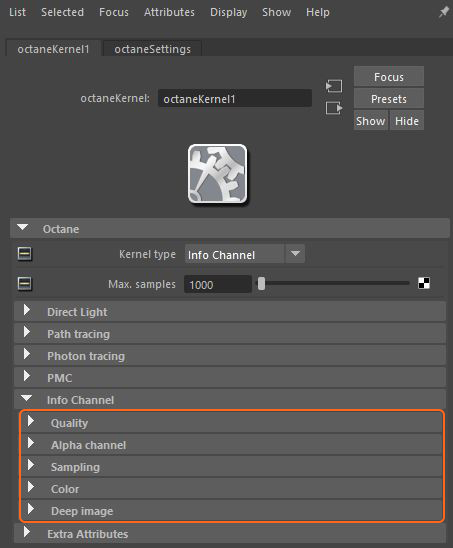
The Info Channel kernel evaluates scene data and renders it as color images to use in post processes for compositing. This Kernel has a series of sub-rollouts of attributes (figure 1).

Figure 1: The Info Channel settings in the Attribute Editor window
Max. Samples - Sets the maximum number of samples per pixel before the rendering process stops. Higher values result in cleaner renders.
Info Channel Type - This parameter specifies the various passes that can be rendered and used in the compositing process.
Ray Epsilon - The distance between the geometry and the light ray when calculating ray intersections for lighting and shadowing. Larger values push rays away from the geometry surface. Smaller values are more accurate, but cause artifacts on large or distant objects. Ray Epsilon is similar to ray tracing bias in other rendering engines. Adjust Ray Epsilon to reduce artifacts in large-scale scenes.
Filter Size - Sets the filter size in terms of pixels. This can improve aliasing artifacts in the render. However, if the filter is set too high, the image becomes blurry.
AO Distance - Sets the maximum spreading distance of the Ambient Occlusion shading.
AO Alpha Shadows - Takes the surface Opacity as determined by its shader into account when rendering using the Ambient Occlusion info channel. Ambient Occlusion shading is based on the surface opacity.
Opacity Threshold - Sets the minimum Opacity value for surfaces when rendering with AO Alpha Shadowing enabled.
Z-Depth Max - Determines the maximum depth as shown in the shading of the Z-depth info channel pass.
UV Max - Sets the maximum value that Texture coordinates can show.
UV Set - Determines the UV set number to use.
Max Speed - Speed mapped to the maximum intensity in the motion vector channel. A value of 1 specifies a maximum movement of 1 screen width in the shutter interval.
Sampling Mode - Enables motion blur and depth of fieldThe distance between the nearest and farthest objects in a scene that appear acceptably sharp in an image. Although a lens can precisely focus at only one distance at a time, the decrease in sharpness is gradual on each side of the focused distance, so that within the DOF, the unsharpness is imperceptible under normal viewing conditions. source: wikipedia (https://en.wikipedia.org/wiki/Depth_of_field), and sets the pixel filtering modes.
Bump And Normal Mapping - Enables Bump and Normal map rendering in images created with Info Channel renders.
Wireframe Backface Highlighting - Enables backface highlighting in the Wireframe channel.
Max Subdivision Level - The maximum subdivision level applied on the scene's geometry. A value of 0 disables subdivision.
Alpha ChannelA greyscale image used to determine which areas of a texture map are opaque and which areas are transparent. - Removes background images or colors created by the SunSky environment node from the rendered image while not affecting any lighting cast by the environment. This is useful if the you want to composite the render over another image without the background being present. Objects appearing in the RGB channels have a bleeding edge, which appear as noise artifacts, but these edges are not included in the Alpha Channel itself.
Parallel Samples - Controls how many samples Octane calculates in parallel. Smaller values require less memory to store the sample's state, but increase render time. Larger values require more memory, but reduce render time. The change in performance depends on the scene and the GPUThe GPU is responsible for displaying graphical elements on a computer display. The GPU plays a key role in the Octane rendering process as the CUDA cores are utilized during the rendering process. architecture.
Max Tile Samples - Controls the number of samples per pixel that Octane will render before storing the result in the render buffer. Higher values mean that results arrive less often in the film buffer.
Minimize Net Traffic - Distributes the same tile to the net render slaves until Octane reaches the max samples-per-pixel for that tile, and then it distributes the next tile to slaves when enabled. This option doesn't affect work done by local GPUs. A slave can merge all of its results into the same cached tile until the master switches to a different tile.
Controls the white light spectrum produced by spectral emitters (daylight, environment, black body).This determines the spectrum that will produce white (before white balance) in the final image.
Deep image rendering stores the Z-depth location of an object with samples of a rendered image. It works best in scenarios where traditional compositing techniques fail, such as compositions where masking out overlapping objects is too difficult, or scenes that render images images using depth-of-field or motion blur, or compositing footage in rendered volumes. Instead of having single RGBA values for a pixel, a deep image stores multiple RGBA channel values per pixel together with a front and back Z-depth (Z and ZBack channels, respectively). This combination (R, G, B, A, Z, ZBack) is called a deep sample.
Most major compositing applications now support deep image compositing. The disadvantage of deep image rendering is the large amounts of memory required to render and store deep images. The standard output format is OpenEXR.
Deep ImageRenders frames with multiple depth samples in addition to typical color and opacity channels. - Enables deep pixel image rendering for deep image compositing.
Maximum Depth Samples - When Deep Image Rendering is enabled, this sets the maximum number of depth samples per pixel.
Depth Tolerance - When Deep Image Rendering is enabled, Octane merges the depth samples whose relative depth difference falls below this value.